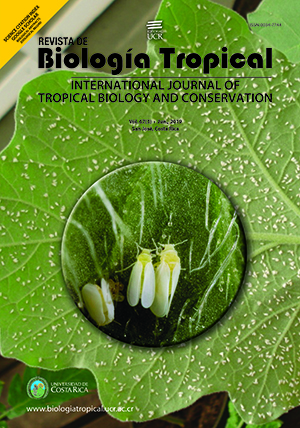Abstract
The physiological condition and immune responses of organisms living at different elevations are expected to display local adaptations to the different climatic and biotic conditions. Small ectotherms with specialized diets are highly susceptible to environmental change, as their life cycle is largely affected by temperature and by the presence of specific resources. This study focuses on two species of rolled-leaf beetles (Chrysomelidae), both present at two different elevations in Costa Rica: Cephaloleia belti Baly, a diet-generalist, and Chelobasis bicolor Gray, a diet-specialist. Body size, energetic condition (lipid storage), muscle mass and immune condition (melanization response) were compared in beetle populations from a tropical rainforest (50 m elevation) and a tropical montane forest (2 000 m elevation). These measurements reflect current and past nutritional condition and hence are good estimators of individual fitness. We analyzed a total of 172 individuals from both species, sexes and elevations. We predicted that beetles at higher elevation would display larger body size, higher energetic condition and lower immune response associated with metabolic requirements and parasitic pressure in colder temperatures. In general, beetles at high altitude were larger, had more lipids and muscle and showed stronger melanization (i.e., immune response) than beetles at low altitudes. Such differences among populations at different elevations may reflect local adaptation to altitude or phenotypic plasticity. However, the effect of elevation was not equivalent amongst species or sex. Measuring physiological traits in organisms with broad elevational distributions could be useful in understanding possible species responses to climate change.
##plugins.facebook.comentarios##

This work is licensed under a Creative Commons Attribution 4.0 International License.
Copyright (c) 2019 Daniel González-Tokman, Fernanda Baena-Díaz, Federico Escobar, Erin Kuprewicz, Carlos García-Robledo






